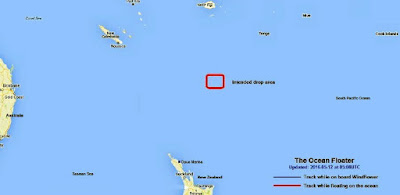Posts Tagged ‘balloons’
 LHS Episode #182: You May Experience Browsiness
LHS Episode #182: You May Experience Browsiness
 In this breathtaking episode of Linux in the Ham Shack, your quasi-intelligent and always goofy hosts discuss new Boy Scout merit badges with a ham radio twist, sending balloons into space, Hamvention, Web browser you may not have heard of, a bunch o' Linux distros, upcoming cons, pineapples, great new music, Scotch and more. Thank you for tuning in and Happy New Year for 2017.
In this breathtaking episode of Linux in the Ham Shack, your quasi-intelligent and always goofy hosts discuss new Boy Scout merit badges with a ham radio twist, sending balloons into space, Hamvention, Web browser you may not have heard of, a bunch o' Linux distros, upcoming cons, pineapples, great new music, Scotch and more. Thank you for tuning in and Happy New Year for 2017.
73 de The LHS Crew
 The ZL1SIX Ocean Floater
The ZL1SIX Ocean Floater

For those of you that are fans of the low-powered "party balloon" floaters, such as the recent S-9 flight by VE3KCL, now comes a different kind of floater and one that really does float ... on the Pacific Ocean!
The "Ocean Floater" is the work of Bob, ZL1RS, who has been very active in tracking the other floaters from his excellent receiving site down-under. Like the balloons, Bob's beacon also utilizes the QRP Labs U3S hardware to transmit data in both WSPR and JT9 modes. The little beacon runs ~100mw on the 30m WSPR band and tracking this one will likely be a bit more challenging than following the high-flying balloons.
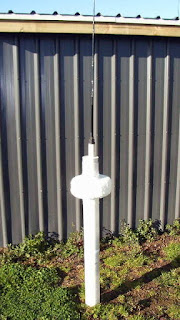 |
| Bob's 'Ocean Floater courtesy: http://www.qsl.net/zl1rs/oceanfloater.html |
Here is Bob's description as he posted to Yahoo Groups QRP Labs:
A small project inspired by Hans' Voyager ideas at
http://www.hanssummers.com/voyager.html ... the Floater is a 100mW
transmitter on the 30m band with a short base-loaded whip antenna
mounted on a buoy that will drift in the Pacific Ocean. It is sending a
standard WSPR transmission once and hour, followed by two JT9
transmissions giving its position, the temperature, and the battery voltage.
The project was deliberately kept very simple. A QRP-Labs U3S
transmitter and firmware made the electronics side easy. The U3S was
rebuilt on a board with a more open layout to allow experimentation and
the addition of a PICAXE controller to switch things on/off as required
to reduce overall battery consumption. Most of the "hard work" was in
the buoy body and antenna. More information about how this went
together can be found at http://www.qsl.net/zl1rs/oceanfloater.html
Today the Floater left on the yacht Windflower to be released into the
south-west Pacific Ocean in a few days time. This will ensure the
Floater is well clear of the coastal currents around ZL that would
otherwise have 'beached' it along the coast if it been launched from the
shore. Unlike balloon flights, things will happen very very slowly, so
updates to the webpage and tracking map will probably only be made on a
daily basis. WSPRnet spots will show the 4 character Maidenhead
locator position, and the JT9 decodes have a 6 character Maidenhead
resolution. Any JT9 decodes you receive will be appreciated via e-mail
to [email protected]
73, Bob ZL1RS
The beacon will use the call "ZL1SIX" and will be launched shortly, near Minerva Reef. Watch Bob's website for tracking and updates and ... good luck Bob!
 LHS Episode #156: Beer and Balloons
LHS Episode #156: Beer and Balloons
 Hello, podcast listeners! In this episode of Linux in the Ham Shack, your intrepid hosts discuss APRS software, Bluetooth TNC hardware, FCC regulations on WiFi hardware, UK ham radio licensing issues, the crazy idea that Microsoft might buy Canonical and much more. Thank you for tuning in, donating and subscribing and just being a friend of the show. Thank you also for sticking it out while we work hard to get back to putting our show out on time despite all of life's obstacles.
Hello, podcast listeners! In this episode of Linux in the Ham Shack, your intrepid hosts discuss APRS software, Bluetooth TNC hardware, FCC regulations on WiFi hardware, UK ham radio licensing issues, the crazy idea that Microsoft might buy Canonical and much more. Thank you for tuning in, donating and subscribing and just being a friend of the show. Thank you also for sticking it out while we work hard to get back to putting our show out on time despite all of life's obstacles.
73 de The LHS Guys
 Another VE3KCL Balloon Adventure
Another VE3KCL Balloon Adventure
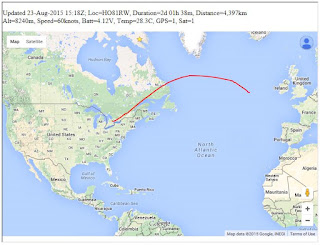 |
| courtesy: http://qrp-labs.com/ and https://www.google.ca/maps/ |
Like earlier flights, 'S-4' also uses a special U3 firmware version on an Arduino Nano board, with a QRP Labs Synthesiser, along with two hydrogen-filled party balloons with HF antennas hung between them. You can read all about Dave's previous flights here and keep up on the balloon's track here.
The balloon is transmitting data regularly on the following schedule:
0:00 CW ID, and 22wpm CW on 30m, 20m and 17m bands
0:01 JT9 on 10,140,450: "#CS#AT" (callsign, altitude)
0:02 JT9 on 10,140,450: "#LT#A0" (latitude, temperature on analogue A0)
0:03 JT9 on 10,140,450: "#LN#A3" (longitude, battery on analogue A3)
0:04 JT9 on 10,140,450: "#M6#GS" (6-char Maidenhead locator, groundspeed)
0:05 JT9 on 14,078,450: "#CS_#M6" (callsign, 6-char Maidenhead locator)
0:06 WSPR on 10,140,250 (standard WSPR transmission)
0:08 WSPR on 10,140,250 with special data telemetry encoding
0:10 22wpm CW on 15m, 10m and 6m bands
0:11 Calibration
0:12 Repeat...
Frequencies to listen on are:
Minute Mode Tag Frequency (Notes)
00:00 CWID. 10.140450 (GPS off)
00:12 CW 05 10.139150
00:27 CW 05 14.100550
00:42 CW 05 18.109150
01:00 JT9 00 10.140450
02:00 JT9 03 10.140450
03:00 JT9 04 10.140450
04:00 JT9 01 10.140450
05:00 JT9 02 14.078450
06:00 WSPR. 10.140250 (normal WSPR)
08:00 WSPR. 10.140250 (encoded WSPR)
09:50 CW 05 21.150150 (GPS on)
10:05 CW 05 28.205150
10:20 CW 05 50.070150
10:35 QRSS. 10.140450 (continuous 'space')
10:55 calibration
12:00 restart the sequence
Let's wish Dave luck and hope that this one makes a successful circumnavigation. It would be the first by a Canadian amateur I believe.
 The VE3KCL Balloons
The VE3KCL Balloons

From the website of Hans Summers (GØUPL) comes news of a 3rd balloon launch from Canada.
David, VE3KCL, used a special U3 firmware version of one of the kits available from QRP Labs and an Arduino Nano board driven by a QRP Labs Si5351A Synthesizer board. Special WSPR codes were used for vehicle telemetry which sent Callsign, Power, Locator, Altitude, Temperature, Battery, Groundspeed, GPS Status and Satellites Found. A 30m HF data download link was used with the help of a full-sized dipole hung between the system's two support balloons as well as a CW identifier on several other bands.
Hans describes the system used:
David VE3KCL launched his third balloon flight S-3 on 28-Jul-2015 at about 11:40Z. Like the former S-2 flight, this one also uses a special U3 firmware version on an Arduino Nano board, with QRP Labs Si5351A Synthesiser. Two foil "party" balloons were used, filled with hydrogen. The earlier balloons S-1 and S-2 apparently suffered burst failure before reaching float altitude due to polluted gas mix - there was a lot of propane mixed in with the hydrogen. This flight S-3 successfully climbed to almost 8,000m so this problem is now solved.
The transmission schedule includes CW on several different bands (for the reverse CW network), 30m JT9 and a special WSPR message on 30m. The special WSPR message types encodes two additional WSPR messages which contain the additional 5th and 6th character of the locator, altitude, battery voltage, temperature, ground speed, GPS status, and number of GPS satellites (a single bit, 0 means under 8, and 1 means 8 or more). The "special" WSPR transmissions therefore show up in the WSPR database with locators and powers which are not the actual locator and power, but encode the additional data. The conversion back to actual flight data is done later in an Excel spreadsheet. This is very experimental at the moment.
 |
| courtesy: VE3KCL, GØUPL and https://www.google.ca/ |
 |
| courtesy: VE3KCL and http://www.qrp-labs.com/ |
More information and pictures of VE3KCL's adventures can be viewed on the QRP Labs website. For those who are software-savvy, it looks like a simple system could be put together with some of the available kits.
PS-46 UPDATE
On another note, it does appear that Andy's amazing Pico-Sat balloon did indeed go down, south of Madagascar, after almost completing its 3rd circumnavigation of the globe.
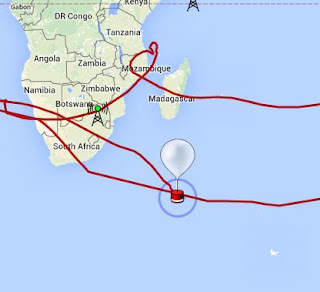 |
| courtesy: http://spacenear.us |
 Andy’s Balloons
Andy’s Balloons
 Like Timex watches, the incredible Picosat balloons of Andy, VK3YT, 'take a licking and keep on ticking'. On May 23rd, Andy launched his PS-46 HF Pico balloon and on June 4th it had arrived back home, completing the circumnavigation of the earth in just 12 days ... but it kept on going. Although taking a little longer this time 'round, PS-46 arrived back over its starting longitude exactly one month later, on July 4th, completing its second circumnavigation of the planet! It slowed briefly enough over the Indian Ocean to trace out this interesting ground track.
Like Timex watches, the incredible Picosat balloons of Andy, VK3YT, 'take a licking and keep on ticking'. On May 23rd, Andy launched his PS-46 HF Pico balloon and on June 4th it had arrived back home, completing the circumnavigation of the earth in just 12 days ... but it kept on going. Although taking a little longer this time 'round, PS-46 arrived back over its starting longitude exactly one month later, on July 4th, completing its second circumnavigation of the planet! It slowed briefly enough over the Indian Ocean to trace out this interesting ground track.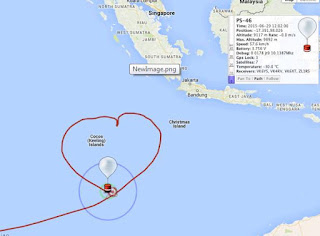 |
| courtesy: http://picospace.net/ |
PS-46 can be tracked via HF packets delivered via JT-9 and WSPR. Frequency information and tracking notes can be found on Andy's website for those interested in tracking the balloon themselves. As well, its track (and other balloons) can be followed on the Spacenear.us website. I think Andy's balloons are very cool and demonstrate a new aspect of amateur radio that was completely unheard of just a few years ago.
Go PS-46!
 Show Notes #109
Show Notes #109
Episode #109 Audio (Listen now!):
Introduction:
After a callsign mixup resulting in Russ calling Pete VE2XPW, the show is off to a flying start.
Mini-Topics:
- Antenna Modelers
- Google Launches Stratospheric Internet Balloons
- The Linux in the Ham Shack Badger hits the Big Time!
Main Topic:
- Field Day
Announcements & Feedback:
- Contest Extended to Episode #110
- To give time for more entries, the contest will be extended. You can become a subscriber or leave a voice mail at 1-909-LHS-SHOW (547-7469). For voice mail entries, remember to complete the thought, “I deserve a Beaglebone Black because,” and make sure to leave contact info. The winner will be announced on Episode #110. Entries must be received by midnight on the day of recording, July 2, 2013.
- E-mail from Gary, KN4AQ, of HamRadioNow.tv
Social Media Roundup:
- Google+
- Terje H (Added)
- Pierre M (Added)
- Peter W (Added)
- Raymund W (Added)
- Rene, PD5RS (Posted)
- Status.net
- To find Russ on any personal Status.net instance (pump.io, identi.ca, etc) use the email [email protected]
Subscribers and Donations:
- Doug (Yearly Subscription)
- Jonas R (Yearly Subscription)
Music:
- “Let This Monkey Go” by Heifervescent from the album Little Egg, courtesy of Jamendo.
- “Open Your Eyes” by Leslie Hunt from the album Your Hair Is on Fire, courtesy of Jamendo.
